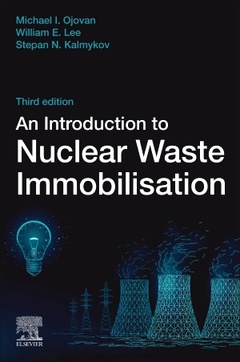An Introduction to Nuclear Waste Immobilisation (3rd Ed.)
Auteurs : Ojovan Michael I., Lee William E., Kalmykov Stepan N.

An Introduction to Nuclear Waste Immobilisation, Third Edition examines nuclear waste issues, including natural levels of radionuclides in the environment, the geological disposal of waste-forms, and their long-term behavior. It covers all-important aspects of processing and immobilization, including nuclear decay, regulations, new technologies and methods. The book has been updated to include a discussion of the disposal of nuclear waste from non-energy sources, also adding a chapter on the nuclear fuel cycle. Significant focus is given to the analysis of the various matrices used, especially cement and glass, with further discussion of other matrices, such as bitumen.
The book's final chapter concentrates on the performance assessment of immobilizing materials and safety of disposal, providing a full range of resources needed to understand and correctly immobilize nuclear waste.
1. Intro2. Nuclear Decay3. Contaminants4. NORM5. Background6. Power NE use7. Non-power NE8. Regulation9. Principles10. Sources11. Short Lived12. Long13. Processing schemes14. Characterization15. Pretreatment16. Treatment17. Cement18. Bitumen19. Glass20. Ceramics21. Transport and Storage22. Disposal23. Performance24. Safety25. Conclusion
Professor Lee has been Co-Director of the Institute of Security Science and Technology (ISST), Chair in Ceramic Science and Engineering, and President of the American Ceramic Society. Previous positions at Imperial include Director of the Centre for Nuclear Engineering, Director of the Centre for Doctoral Training in Nuclear Energy (with Cambridge and The Open Universities), and Director of the Centre for Advanced Structural Ceramics. He is a member of the Government advisory committee The Nuclear Innovation and Research Advisory Board (NIRAB), the Leverhulme Trust Panel of Advisors, the Royal Academy of Engineering International Activities Committe
- Focuses on core technologies and an integrated approach to immobilization and hazards
- Includes new scientific findings on wasteform performance and novel technological developments
- Provides expanded coverage on decommissioning waste, including clearance of bulk materials from regulatory control and novel processing approaches
- Focuses on different matrices used in nuclear waste immobilization, including cement, bitumen, glass and new materials
Date de parution : 04-2019
Ouvrage de 512 p.
15x22.8 cm
Thèmes d’An Introduction to Nuclear Waste Immobilisation :
Mots-clés :
Nuclear; radioactive waste; remediation; decontamination; contaminated; nuclear storage; decommissioning



